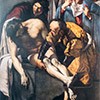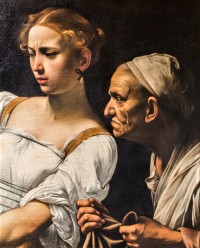Dirck van Baburen (approx. 1592/93–1624) – a short, intense life of a Caravaggionist from the North
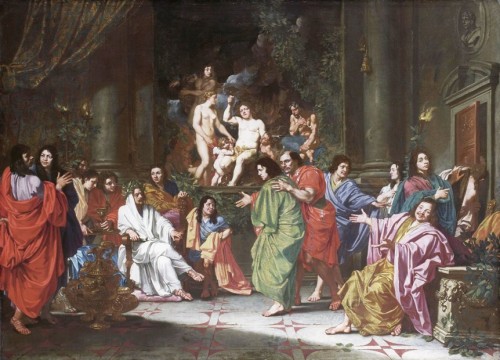
Initiation in the Roman brotherhood of Bentvueghels, anonymous painter, pic. Wikipedia

Dirck van Baburen, The Entombment, Pieta Chapel, Church of San Pietro in Montorio
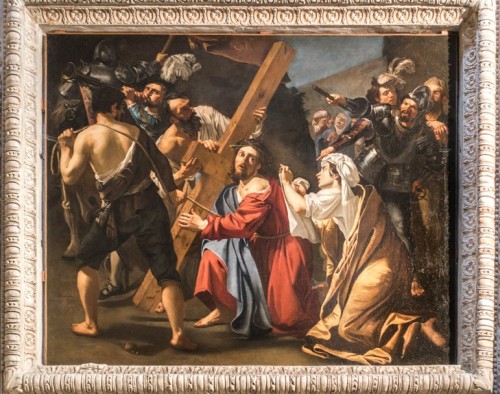
Dirck van Baburen, Fall under the cross, Pieta Chapel, Church of San Pietro in Montorio
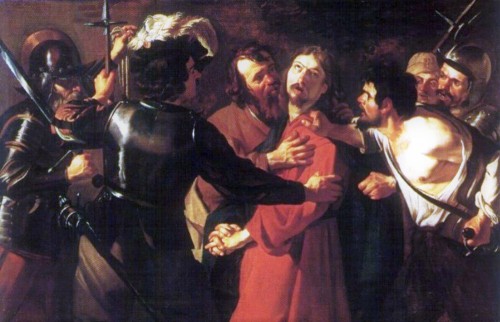
Dirck van Baburen, The Capture of Christ, Galleria Borghese
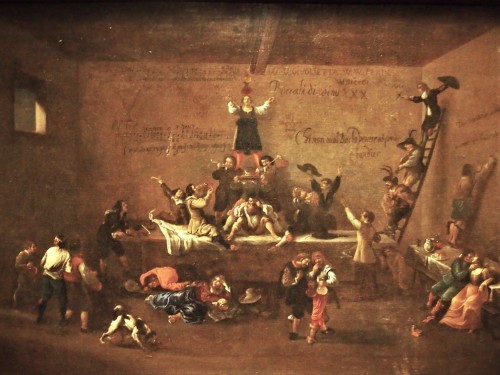
Bentvueghels brotherhood in one of the Roman osteria, pic. Wikipedia
Although Caravaggio had already been dead for several years, his legendary figure, like a magnet, attracted young artists to Rome. They came to see his works, immerse themselves in the atmosphere of the ancient city, and take part in the vibrant artistic life of the then-center of art. Some of them came from the distant city of Utrecht. Among these were Gerrit van Honthorst and Dirck van Baburen. In the city, on the Tiber, they had a lot of fun, studied, exchanged ideas on artistic achievement, and competed for commissions. They were the informal students, and par excellence continuators of Caravaggio – a generation that popularized his art all across Europe. They have become known as Caravaggionists.
Although Caravaggio had already been dead for several years, his legendary figure, like a magnet, attracted young artists to Rome. They came to see his works, immerse themselves in the atmosphere of the ancient city, and take part in the vibrant artistic life of the then-center of art. Some of them came from the distant city of Utrecht. Among these were Gerrit van Honthorst and Dirck van Baburen. In the city, on the Tiber, they had a lot of fun, studied, exchanged ideas on artistic achievement, and competed for commissions. They were the informal students, and par excellence continuators of Caravaggio – a generation that popularized his art all across Europe. They have become known as Caravaggionists.
Karel van Mander, in encouraging painters to travel to Rome, claimed in his The Book of Painters (1604) that, Caravaggio "creates wonderful things there". However, the tradition of going to the city on the Tiber had already been alive and well in Utrecht for several generations. During the Reformation, it grew in importance due to the ties connecting the city – the seat of the bishopric and an important Catholic center in the northern Netherlands – with the heart of the Catholic world. Van Mander also made sure to warn young artists about the traps which awaited them during their stay in Rome, which this Flemish painter and art theoretician probably came to know firsthand. And thus, he recommended not to lend money to Italians, not get into quarrels, and above all stay away from women of questionable reputation, since the consequences of such deeds may be dire indeed. One must get to know the Italian customs but does not need to succumb to all of them. A young adept of the arts such van Baburen had probably read van Mander’s book, and perhaps possessed a map of Rome published in the Netherlands. He may have even already known several Italian phrases, from the Italian-Dutch dictionary, which contained basic phrases, asking about the way, or words that allowed one to place an order in the tavern.

The artist was born in the Protestant-governed Utrecht, in which Catholics constituted a respected minority. However, we know nothing about his religious affiliation. The Utrecht-painting school was represented by two outstanding Mannerists: Abraham Bloemaert and Paulus Moreelse. Van Baburen was a student of the former, while his education was primarily based on training in drawing in order to achieve mastery and a sure hand. The teenage youth left Utrecht in 1612 (or at the beginning of 1613). What did he do afterward – we do not know. Did he come to Rome, or perhaps he travel around in other Italian cities? It is difficult to say. We do know that in 1615 he painted an altar reredos (unpreserved) in Parma, while in 1617 he received an important commission in the city on the Tiber. He also caught the eye of outstanding Roman collectors – Vincenzo Giustiniani and Scipione Borghese. The collections of the Giustiniani brothers, one of the most admired art collections of that time included two of van Baburen’s (known as Teodoro fiamengo) paintings, including an almost two-meter Christ Washing the Apostles Feet (presently Berlin, Gemäldegalerie). There, the young artist was able to admire Caravaggio’s canvases, of course apart from those works, which were found in Roman churches. Most likely also due to their favor he found subsequent clients. The most important of these was the Spanish ambassador and art collector Pietro Cuside (Cussida), who entrusted the Dutchman with a comprehensive painting decoration of his newly-created chapel in the Church San Pietro in Montorio, which – as it would turn out – will be applauded and admired by the Roman artistic community. The principal painting in the chapel, The Entombment, would be created by Baburen himself, while the remaining canvases would be completed along with his colleague, the Amsterdam-born David de Haen. They shared not only commissions but also (between 1619-1620) a flat on Piazza della Trinità dei Monti – a place which was willingly inhabited by artists at that time. The rent in Rome was quite steep, therefore living together made perfect sense, especially because the flat also served as a workshop. In time the Frenchman Nicolas Régnier also moved in with them. They all "spied" on Caravaggio, attempting to create on the basis of his paintings, something new and original. However, Caravaggio was not the only person to inspire van Baburen. Others included another of the Caravaggionists greatly valued in the Eternal City – Bartolomeo Manfredi, as well as the young, charismatic Spaniard – Jusepe de Ribera. They competed against one another, but they also inspired one another – undertaking similar topics, they borrowed color schemes, compositions, and figures, creating more and more elaborate and artistically novel solutions. Together they went out to taverns, visited art merchants, talked about art, drank, and painted. In a noisy city, full of foreigners, pilgrims, vagabonds, prostitutes, and all kinds of tricksters, they made up the international, artistic bohème. The painter was also a member of the Bentvueghels – an informal fraternity that brought together artists from the Netherlands (Dutch and Flemish), who declared themselves as the faithful of Bachus. Their meetings, which were targeted at aiding one another and establishing stronger ties were the talk of all Rome, due to excessive alcohol consumption, and quarrels and conflicts with law enforcement. In the fraternity, the painter was given the nickname Biervliech due to his great love of beer.

Van Baburen spent several years in the Eternal City. At that time he created paintings marked with strong chiaroscuro, bringing out of the dimness intense colored patches, compositions created in little space, with figures tightly bunched together, placed so close to the viewer, as if they would be speaking directly to him.
The artist left Rome in 1620 (or at the start of 1621). He stayed with his mother and sister in Utrecht and got married. He painted genre scenes (the famous The Procuress, Stewart Gardner Museum, Boston), images of musicians and singers, mythological scenes, as well as outstanding religious scenes (Crowning with Thorns, Museum Catharijneconvent, Utrecht). He died slightly before his thirtieth birthday, during an epidemic, which befell the city at that time. He left behind thirty-eight works.
Paintings of the artist in Rome:
- The Entombment, Jesus Under the Cross, 1617, Pieta Chapel in the Church of San Pietro in Montorio
- The Capture of Christ, 1619, Galleria Borghese







